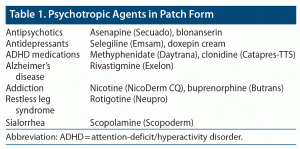aDepartment of Psychiatry, Al-Manara CAP Centre, Kuwait Centre for Mental Health, Jamal Abdul-Nassir St, Shuwaikh, State of Kuwait
*Corresponding author: Ahmed Naguy, MBBch, MSc, Department of Psychiatry, Al-Manara CAP Centre, Kuwait Centre for Mental Health, Jamal Abdul-Nassir St, Shuwaikh, Sulibikhat 21315, Kuwait ([email protected]).
Prim Care Companion CNS Disord 2021;23(2):20br02673
To cite: Naguy A. Transdermal psychotropic agents: “aye” or “nay”? Prim Care Companion CNS Disord. 2021;23(2):20br02673.
To share: https://doi.org/10.4088/PCC.20br02673
© Copyright 2021 Physicians Postgraduate Press, Inc.
One way to turn a drug into a slow-release preparation is through transdermal delivery systems (TDS) or patches. Essentially, the active drug is placed into a gel-like substance that is adhered to an impermeable backing. Next, adhesive glue is placed along the perimeter of the patch to adhere it to the patient’s skin. Pressure and constant drug-to-skin contact are ensured, and the active drug is gradually absorbed through skin capillaries, allowing for slow constant absorption.1
TDS for psychotropic medications sounds attractive. It is a user-friendly approach with less-frequent dosing. It is especially convenient for patients with dysphagia commonly seen in neurologic wards, the pediatric population with difficulty swallowing oral formulations, or those with gastrointestinal ailments. Moreover, TDS provides a visual proof of treatment adherence—a top priority in psychiatric patients. Given the reduced hepatic first-pass metabolism, this would translate into less drug-drug interactions for patients on polypharmacy. It allows for constant serum levels (zero-order kinetics) that stop upon removal of the patch. Last but not least, TDS is obviously hassle free with minimal risk of overdosing—again, an important consideration in suicidal patients.2
On the other hand, TDS has some potential downsides. A major hurdle is the limited availability of therapeutic options—only a handful of psychotropic agents come in TDS formulations (Table 1). Local skin reactions at application sites are quite ubiquitous. Erratic absorption (as hair or sweating may interfere) and, hence, unpredictable bioavailability can be problematic. Slower actions and steady state are only maintained as long as the patch is applied, and this renders TDS impractical for emergencies. Furthermore, TDS is expensive.3
Despite these uncertainties, TDS might open new customized treatment venues, expanding our pharmacopeia, and represents a welcomed addition to the psychopharmacologic armamentarium that begins to gather a momentum on clinical grounds. However, time will tell with regard to its real position in clinical practice.
Psychotropics in patch form currently on the market include the following:
Antipsychotics: Two atypical antipsychotics are currently available in patch form. One is asenapine (Secuado) that recently has been granted US Food and Drug Administration (FDA) approval for adult schizophrenia (and bipolar mood disorder) to be applied at 3.8 mg every 24 hours to the hip, abdomen, upper arm, or upper back.4 The other is blonanserin, which is available exclusively in Japan.
Antidepressants: The monoamine oxidase-B inhibitor selegiline (Emsam) comes in 3 sizes—one of which is 20 mg/20 cm2 that delivers almost 6 mg over 24 hours and, hence, abrogates the need for a tyramine-restricted diet. It is also indicated in Parkinson disease.5 The tricyclic antidepressant doxepin, due to its strong antihistaminic H1 actions, comes in a 5% cream (Zonalon) for short-term use (8 days) for moderate pruritus in adults with atopic dermatitis or lichen simplex chronicus.
For attention-deficit/hyperactivity disorder (ADHD), methylphenidate patches (Daytrana) should be applied to the hip area (using alternating sites) 2 hours before an effect is needed and should be removed 9 hours after application. This stimulant is FDA approved for children with ADHD aged ≥ 6 years.6 Similarly, clonidine, the α2 agonist, is available as Catapres-TTS.7
For Alzheimer’s disease, the acetylcholine esterase (and also butyrylcholinesterase) inhibitor rivastigmine comes in patch form (Exelon patch) to start at 4.6 mg/24 hours. It is also indicated for Parkinson disease dementia.8
For smoking cessation, nicotine patches (NicoDerm CQ) are available. Those who smoke more than 10 cigarettes a day should start at 21 mg for 6 weeks, then 14 mg for 2 weeks, and, finally, 7 mg for 2 weeks.9
Buprenorphine, the µ opiate partial agonist and ĸ opiate antagonist, is available as Butrans 5 µ/hour for analgesia and can be used for opiate use disorder.10
Rotigotine, the non-ergot more selective dopamine D3 agonist, comes in Neupro 2-mg/24-hour patches for Parkinson disease and restless leg syndrome.11
The anticholinergic hyoscine is available as Scopoderm 1.5-mg patches covering up to 72 hours that can be used in children aged ≥ 10 years and adults for motion sickness. It is sometimes used in psychiatry for psychotropic-induced sialorrhea (eg, clozapine).12
Published online: April 1, 2021.
Potential conflicts of interest: None.
Funding/support: None.
References (12)

- Prausnitz MR, Langer R. Transdermal drug delivery. Nat Biotechnol. 2008;26(11):1261–1268. PubMed CrossRef NLM
- Isaac M, Holvey C. Transdermal patches: the emerging mode of drug delivery system in psychiatry. Ther Adv Psychopharmacol. 2012;2(6):255–263. PubMed CrossRef NLM
- Stevens JR, Justin Coffey M, Fojtik M, et al. The use of transdermal therapeutic systems in psychiatric care: a primer on patches. Psychosomatics. 2015;56(5):423–444. PubMed CrossRef NLM
- Naguy A, Alamiri B. 2019 FDA approved psychotherapeutic medications. Asian J Psychiatr. 2020;49:101976. PubMed NLM
- Barrett JS, Hochadel TJ, Morales RJ, et al. Pharmacokinetics and safety of a selegiline transdermal system relative to single-dose oral administration in the elderly. Am J Ther. 1996;3(10):688–698. PubMed CrossRef NLM
- Naguy A. Psychopharmacotherapy of attention deficit-hyperactivity disorder in children with comorbid conditions. Pediatr Neurol. 2018;82:7–12. PubMed CrossRef NLM
- Naguy A. Clonidine use in psychiatry: panacea or panache. Pharmacology. 2016;98(1–2):87–92. PubMed CrossRef NLM
- Naguy A, AlHumoud A. An octogenarian with Parkinson’s disease psychosis that has responded favourably to low-dose sulpiride with facilitated motoric agility. Asian J Psychiatr. 2019;43:55–56. PubMed CrossRef NLM
- Schnoll RA, Goelz PM, Veluz-Wilkins A, et al. Long-term nicotine replacement therapy: a randomized clinical trial. JAMA Intern Med. 2015;175(4):504–511. PubMed CrossRef NLM
- Dankiewicz EH. Use of the low-dose buprenorphine patch: a response. J Palliat Med. 2014;17(4):379–380. PubMed CrossRef NLM
- Sanford M, Scott LJ. Rotigotine transdermal patch: a review of its use in the treatment of Parkinson’s disease. CNS Drugs. 2011;25(8):699–719. PubMed CrossRef NLM
- Naguy A, Alamiri B, Khraibut B. Weight loss during atomoxetine add-on to clozapine-responsive schizophrenia. Am J Ther. 2018;25(6):e774–e775. PubMed CrossRef NLM
Please sign in or purchase this PDF for $40.
Save
Cite


